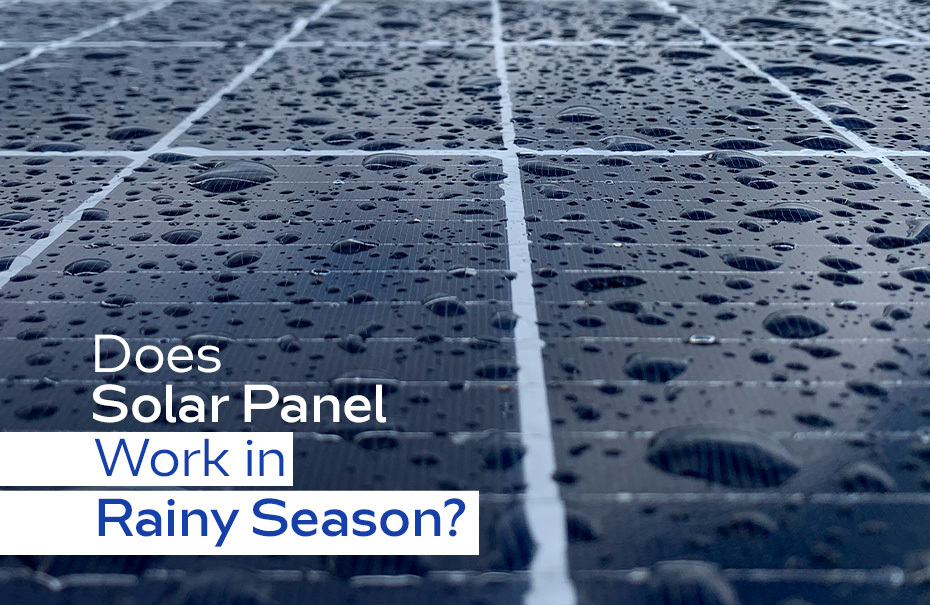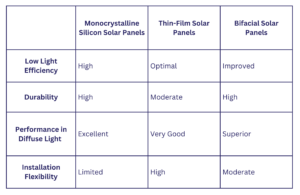Does Solar Panel Work in the Rainy Season?

The photovoltaic effect is what makes solar panels so effective at transforming sunlight into usable power. Photons, tiny bits of light, are essential to this process because they strike the solar panels’ surfaces, which in turn release electrons from the atoms that make up the panels. You can capture this electric current that flows through the solar cells and use it to power electrical devices. After considering this, it seems to reason that solar panels produce the most electricity when the sun is directly above, doesn’t it?
Now you must be wondering, “Does solar module technology work in the rainy season”? The short answer is yes, they do. Although solar panels work best when the sun is directly above, they can continue to generate power even on cloudy days.
What happens to your Solar System in the Rainy Season?
Solar panels don’t get as much light when it’s cloudy or raining. That limits the amount of power your panels can generate compared to when the sun is shining directly on them. If the weather is overcast, they might only be able to produce 30% to 50% of their maximum output. When it’s raining, however, that figure plummets even more, perhaps to as low as 10% to 20%.
You need to use additional grid power if your solar panels aren’t producing enough juice. During cloudier seasons, your energy savings might be lower.
One bright side, though: solar panels are water-resistant and continue to produce electricity regardless of the weather. Even when they aren’t running at full capacity, they help you cut down on your carbon emissions and produce power. Also, you won’t be left in the dark when clouds move in since you can store back any surplus energy your panels create while it’s bright.
What about Battery Storage on Cloudy Days?
To answer your question “Does solar module technology work in the rainy season?”, well, it does, and there also comes the question of battery storage. if it’s raining the whole day and solar panels don’t generate electricity, there’s always the battery storage to turn to.
When your solar panels are generating more electricity than you use, you may store it in a solar battery. Your batteries should still have sufficient power to last you through the glooming weather if you had a stretch of bright days before the clouds arrived.
Additionally, your solar panels are still producing power, even if they aren’t operating at full capacity. So, even on overcast days, the electricity they provide will help keep your batteries charged.
Tips to use Solar Panels during Rainy Season
Solar Panels most definitely produce electricity on rainy days. However, if you just follow a few tips, you can multiply it.
Keep the Panels Clear from the Shadows
Solar panels can continue to produce power regardless of weather conditions, provided that they get at least some direct sunlight. On the other hand, when it rains, the sun doesn’t shine as brightly, therefore there may be less power generated.
Solar panels must be installed in areas that can get direct sunlight for most of the day in order to produce the most energy feasible. For this reason, it is essential to arrange the panels so that they do not throw shadows on one another or nearby structures or trees during the installation procedure.
Reduced sunlight reaching the panels diminishes their ability to generate power, and shadows can have a major impact on this. To maximize the effectiveness of solar panels, it is essential to ensure that they are not shaded, particularly during the rainy season when sunlight is already at a minimum.
Make Sure They are Well-Angled
If you own solar panels and have them installed on your roof, you can use rainwater to keep your panels clean and increase their effectiveness. For rainfall to thoroughly wipe the panel surface, strategic positioning of the panels is essential. You can make use of rain’s self-cleaning capabilities by setting up the panels at angles that let water glide off naturally. This helps to remove any dirt, dust, or other material that may have settled on the surface of the panels over time, ensuring that the panels can absorb sunlight and produce energy at their full potential.
Additionally, the panels provide extra protection against high winds during rainstorms and also help with rainfall flow when installed at a natural angle. You can reduce the likelihood of damage or displacement caused by bad weather by installing the panels firmly, which will increase the lifetime and durability of your solar energy system.
Furthermore, to maximize the production of solar energy, the panels must be angled correctly. You can maximize the effectiveness of your solar panels by altering the tilt to follow the sun’s course throughout the day. Even on days with less sunlight, such as rainy or gloomy days, you can still get the most out of the sun by doing this.
Monitor the Energy Regularly
Similar to checking the gas gauge on the car to make sure you don’t run out of petrol, monitoring the energy generation of your solar panels is an excellent practice. It’s critical to monitor the output of your panels and ensure that everything is functioning properly.
You can see the amount of electricity your panels produce in real time using monitoring software. If your energy output suddenly drops, it might mean something is wrong. Perhaps one of your panels is malfunctioning or a nearby tree is casting a shadow on them.
You can detect these problems early and take corrective measures by monitoring your panel’s energy output. Comparable to getting a checkup for your panels, it ensures they are in good health and functioning properly. Getting a checkup for your panels is equivalent to ensuring they are in good health and functioning properly. That way, you can be confident your solar panels are still producing electricity, even when it’s raining.
Schedule Professional Checks
Professionals will visit your house to examine your solar panel system when you arrange for maintenance. They will make sure that your solar energy system is functioning properly by inspecting each and every component.
They will clean your solar panels during the examination to remove any debris, dust, or grime that might be obstructing the sunlight. It doesn’t matter whether it’s raining or not; clean panels can still collect more sunlight and generate more electricity.
Your solar energy system’s wiring and inverters are only two of the many components that the specialists will inspect for proper functioning. They can address any concerns promptly to avoid more significant ones in the future.
Best Solar Panel for Cloudy Weather
Even on cloudy days, solar panels can provide excellent results because of technological developments that allow them to work even in low-light situations.
Monocrystalline Silicon Solar Panels
When it comes to turning sunlight into energy, monocrystalline silicon panels are the way to go. They are very efficient and precise, making them perfect for use in low-light settings. Even in low-light conditions, including on overcast days, their single crystal structure enables them to precisely absorb and exploit sunlight. As a result of this, they are especially reliable in places where there is a lot of cloud cover or when the daytime hours are shorter. Their consistent design and sleek black color appeal to homeowners for both aesthetic and functional reasons, regardless of the lighting circumstances.
Thin-Film Solar Panels
During the rainy months, thin-film solar panels really shine because of how well they work in low-light settings. The ability of thin-film panels to catch a larger range of light results in effective energy production even when the sky is overcast. Due to their increased capacity for absorption, they are particularly useful on cloudy days when sunlight is scarce, guaranteeing a steady flow of electricity even in bad weather. The other benefits of thin-film panels are their lightweight design and adaptability.
Bifacial Solar Panels
Bifacial modules are very efficient since they can soak up light from both the front and back of the device. Their design, which incorporates a glass back surface or transparent sheet, is the major innovation. Due to this quality, bifacial panels can soak up sunlight that has reflected off of adjacent objects, such as the ground or buildings. Bifacial modules can create energy even on overcast days with minimal direct sunshine by catching this reflected light, maintaining a steady supply of power independent of weather changes.
They can collect more sunlight owing to their double-sided construction, which means they can generate more power from the same amount of space. Additionally, bifacial panels work better in low-light situations, making them very effective even on cloudy or partially shaded days.
Let’s compare these three types of solar panels during the rainy season.

Rain or Shine: Vishakha Renewables is By Your Side!
To sum up, Vishakha Renewables’ – biggest manufacturer of solar panel components, are on a mission to provide renewable energy projects around the globe with premium solar panels. Producing 10 GW of renewable energy by 2027 is our ambition as a manufacturer of solar panel frames, encapsulants, back sheets, and glass. In our efforts to satisfy our customers’ varied demands and help ensure the planet’s long-term viability, we remain committed to our core principles of honesty, quality, and innovation.
The significance of maintaining the solar panel performance even during rainy seasons is something we at Vishakha Renewables have a good grasp on. You can rely on us to provide the highest quality solar panel components for all of your requirements, rain or shine since we are dedicated to quality and client satisfaction.
FAQs
Do Solar Panels Work on Cloudy Days?
Solar panels can often operate in the rain since they are intended to catch and convert light into power. Even during wet or gloomy weather, they will continue to produce electricity, although at a lower efficiency.
How can we protect solar panels from rain?
Installing solar panels at an angle that facilitates water drainage will shield them from precipitation. Cleaning the panels on a regular basis to remove dirt and debris that can develop during wet weather is one example of regular maintenance that can assist maximize their efficiency. Also, to make sure they can handle rain over time, choose high-quality panels made of sturdy materials.
Do solar panels charge at night?
Solar panels generate no electricity at night. However, they tend to generate more electricity during the day when the sun is out. To balance things out and keep the power going after dark, solar users employ solar battery banks or net metering.
What time of the day works best for solar panels?
The best time to utilize solar-generated power is during the middle of the day, when the sun is at its brightest, which is generally between 9 a.m. and 3 p.m. These peak hours can vary based on the direction and tilt of your panels, as well as your location and time of year.
Do solar panels work in fog?
Solar panels function by capturing sunlight. Even in low-light or foggy situations, the panels can gather solar energy. However, the capacity will be a little decreased. Currently, most solar panels operate at around 50% efficiency under foggy circumstances.
Explore More
